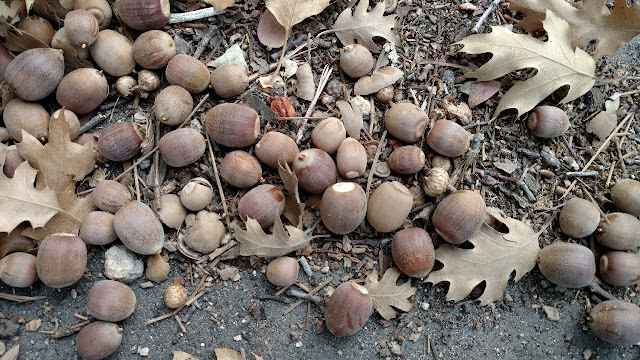
|
|
California oaks are dropping lots of acorns this fall. (Photo: Debbie Arrington)
|
Got acorns? If you have oaks, it’s likely you’re seeing plenty this season.
“It is a good acorn year!” said restoration ecologist Zarah Wyly, director of urban ecology for the Sacramento Tree Foundation. “Finally, something went well in 2020.”
Although acorns are plentiful this fall (making countless squirrels very happy), this harvest doesn’t quite measure up to what’s known as a “mast year.”
“I don't know if it is quite up to the ‘mast year’ level of acorn madness,” Wyly observed. “I have been describing this as a good acorn year and nothing more. My experience with past mast years – I feel I have experienced two in the last 15 years of oak watching in the Sacramento area – was that pretty much every oak tree had a crop. While there are lots of acorns available, it isn't quite at that level.”
Wyly oversees acorn collection for the foundation, which annually harvests acorns to grow native oaks for replanting. A good acorn crop helps.
“I have a group of 45 human squirrels out gathering it up to grow the next generation of native oaks,” she said. “This is always easier and more fun when acorns are easier to find.”
How many acorns will they harvest?
“Our volunteer acorn harvesters gather between 7,000 to 10,000 acorns from local native oaks each year depending on our planned seed needs,” Wyly said. “Since we started doing this with volunteers in 2010, we have harvested over 100,000 acorns!”
Rarely do all local oaks have big harvests at the same time. Part of the reason: Not all acorns ripen at the same pace.
“Locally, we can have oaks having a good year and some having a bad year,” Wyly explained, “as our valley oak (
Quercus lobata
) and blue oak (
Quercus douglasii
) produce ripe acorns over about eight months whereas our local interior live oak (
Quercus wislizeni
) produces ripe acorns over about 20 months. So, the crop we are seeing right now was the pollen making us sneeze this March and March 2019 respectively.
“Differences in these years, such as very rainy weather, can impact pollination and the subsequent acorn crop,” she added. “From what I have seen, all three of these local native species are having a very good year this fall.”
Non-native oaks are having a good crop, too, but that’s more common for those species.
“As for our non-native oaks, some of them are much more reliable acorn producers,” Wyly said. “For example, the cork oak (
Quercus suber
) and the holly oak (
Quercus ilex
) seem to have acorns every year and in large number. I imagine this has to do with species differences including possibly the ability to self-pollinate and/or impacts from urban living where they receive more water than they might in their natural home (Europe). There isn't a ton of research on this.”
As for what so many acorns may portend? According to folklore, an abundance of acorns signals a bad winter ahead. The Old Farmer’s Almanac recently asked readers for their acorn experiences. Judging by the responses, most of the country is in for a cold winter.
Or a lot of happy squirrels.

